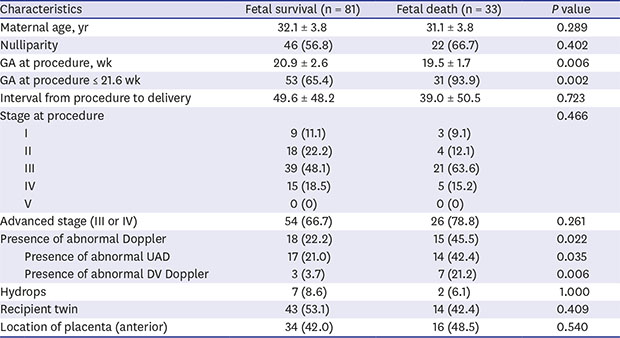1. Urig MA, Clewell WH, Elliott JP. Twin-twin transfusion syndrome. Am J Obstet Gynecol. 1990; 163(5 Pt 1):1522–1526.


2. Duncan KR, Denbow ML, Fisk NM. The aetiology and management of twin-twin transfusion syndrome. Prenat Diagn. 1997; 17(13):1227–1236.


3. Senat MV, Deprest J, Boulvain M, Paupe A, Winer N, Ville Y. Endoscopic laser surgery versus serial amnioreduction for severe twin-to-twin transfusion syndrome. N Engl J Med. 2004; 351(2):136–144.


4. Rossi AC, D'Addario V. Laser therapy and serial amnioreduction as treatment for twin-twin transfusion syndrome: a metaanalysis and review of literature. Am J Obstet Gynecol. 2008; 198(2):147–152.


5. Chang YL, Chao AS, Chang SD, Hsieh PC, Wang CN. Short-term outcomes of fetoscopic laser surgery for severe twin-twin transfusion syndrome from Taiwan single center experience: demonstration of learning curve effect on the fetal outcomes. Taiwan J Obstet Gynecol. 2012; 51(3):350–353.


6. Quintero RA, Dickinson JE, Morales WJ, Bornick PW, Bermúdez C, Cincotta R, et al. Stage-based treatment of twin-twin transfusion syndrome. Am J Obstet Gynecol. 2003; 188(5):1333–1340.


7. Cincotta RB, Gray PH, Gardener G, Soong B, Chan FY. Selective fetoscopic laser ablation in 100 consecutive pregnancies with severe twin-twin transfusion syndrome. Aust N Z J Obstet Gynaecol. 2009; 49(1):22–27.


8. Morris RK, Selman TJ, Harbidge A, Martin WI, Kilby MD. Fetoscopic laser coagulation for severe twin-to-twin transfusion syndrome: factors influencing perinatal outcome, learning curve of the procedure and lessons for new centres. BJOG. 2010; 117(11):1350–1357.


9. Yang X, Leung TY, Ngan Kee WD, Chen M, Chan LW, Lau TK. Fetoscopic laser photocoagulation in the management of twin-twin transfusion syndrome: local experience from Hong Kong. Hong Kong Med J. 2010; 16(4):275–281.

10. Rustico MA, Lanna MM, Faiola S, Schena V, Dell'avanzo M, Mantegazza V, et al. Fetal and maternal complications after selective fetoscopic laser surgery for twin-to-twin transfusion syndrome: a single-center experience. Fetal Diagn Ther. 2012; 31(3):170–178.


11. Ek S, Kublickas M, Bui TH, Dellgren A, Papadogiannakis N, Tiblad E, et al. Establishing a national program for fetoscopic guided laser occlusion for twin-to-twin transfusion syndrome in Sweden. Acta Obstet Gynecol Scand. 2012; 91(10):1196–1200.


12. Halvorsen CP, Ek S, Dellgren A, Grunewald C, Kublickas M, Westgren M, et al. Survival and neonatal outcome after fetoscopic guided laser occlusion (FLOC) of twin-to-twin transfusion syndrome (TTTS) in Sweden. J Perinat Med. 2012; 40(5):533–538.


13. Stirnemann JJ, Nasr B, Essaoui M, Bussieres L, Ville Y. A nomogram for perioperative prognostic risk-assessment in twin-twin transfusion syndrome. Prenat Diagn. 2013; 33(2):103–108.


14. Teoh M, Walker S, Cole S, Edwards A. ‘A problem shared is a problem halved’: success of a statewide collaborative approach to fetal therapy. Outcomes of fetoscopic laser photocoagulation for twin-twin transfusion syndrome in Victoria. Aust N Z J Obstet Gynaecol. 2013; 53(2):108–113.


15. Baschat AA, Barber J, Pedersen N, Turan OM, Harman CR. Outcome after fetoscopic selective laser ablation of placental anastomoses vs equatorial laser dichorionization for the treatment of twin-to-twin transfusion syndrome. Am J Obstet Gynecol. 2013; 209(3):234.e1–234.e8.
16. Peeters SH, Van Zwet EW, Oepkes D, Lopriore E, Klumper FJ, Middeldorp JM. Learning curve for fetoscopic laser surgery using cumulative sum analysis. Acta Obstet Gynecol Scand. 2014; 93(7):705–711.


17. Has R, Kalelioglu I, Corbacioglu Esmer A, Ermis H, Dural O, Dogan Y, et al. Stage-related outcome after fetoscopic laser ablation in twin-to-twin transfusion syndrome. Fetal Diagn Ther. 2014; 36(4):287–292.


18. Müllers SM, McAuliffe FM, Kent E, Carroll S, Mone F, Breslin N, et al. Outcome following selective fetoscopic laser ablation for twin to twin transfusion syndrome: an 8 year national collaborative experience. Eur J Obstet Gynecol Reprod Biol. 2015; 191:125–129.

19. Diehl W, Diemert A, Grasso D, Sehner S, Wegscheider K, Hecher K. Fetoscopic laser coagulation in 1020 pregnancies with twin-twin transfusion syndrome demonstrates improvement in double-twin survival rate. Ultrasound Obstet Gynecol. 2017; 50(6):728–735.


20. Van Winden KR, Quintero RA, Kontopoulos EV, Korst LM, Llanes A, Chmait RH. Perinatal survival in cases of twin-twin transfusion syndrome complicated by selective intrauterine growth restriction. J Matern Fetal Neonatal Med. 2015; 28(13):1549–1553.


21. Akkermans J, Peeters SH, Klumper FJ, Lopriore E, Middeldorp JM, Oepkes D. Twenty-five years of fetoscopic laser coagulation in twin-twin transfusion syndrome: a systematic review. Fetal Diagn Ther. 2015; 38(4):241–253.


22. Delabaere A, Leduc F, Reboul Q, Fuchs F, Wavrant S, Fouron JC, et al. Prediction of neonatal outcome of TTTS by fetal heart and Doppler ultrasound parameters before and after laser treatment. Prenat Diagn. 2016; 36(13):1199–1205.


23. Rossi AC, D'Addario V. Comparison of donor and recipient outcomes following laser therapy performed for twin-twin transfusion syndrome: a meta-analysis and review of literature. Am J Perinatol. 2009; 26(1):27–32.











 PDF
PDF Citation
Citation Print
Print




 XML Download
XML Download